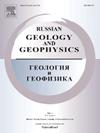西伯利亚地台第一快速圈闭侵入顶Kureika石墨矿床岩石学特征
IF 1
4区 地球科学
Q3 GEOSCIENCES, MULTIDISCIPLINARY
引用次数: 0
摘要
——证实了岩石地层、构造/构造、岩浆、变质和流体地质因素在石墨矿床形成中的主导作用。给出了火成岩岩石和矿物的岩石学和化学组成,石墨和方解石的δ13С值,碳酸盐的δ18O值,硫化物的δ34S值,方解石和微白云石注入物的87Sr/86Sr和87Rb/86Sr比值。岩浆熔体对煤的热效应导致煤脱气和石墨化。注入微白云石的烃类流体可能伴随着其中的铁的去除和低铁斜辉石的结晶,流体与侵入体上部内接触带玄武岩熔体的相互作用导致熔体的分离和岩石球形结构的形成。在岩体顶板与石墨层之间存在方解石透镜体和硫化物脉体,这是由于较早的硫酸盐盐熔体侵入及其与烃类流体的相互作用,导致硫酸盐还原而形成方解石。硫酸盐还原以玄武岩熔体中铁的硫化和硫化物脉的形成而终止。硫酸盐盐熔体是硫化物重硫同位素(δ34S = 14.9 ~ 17.5‰)和方解石钙的来源。方解石(δ13СPDB = -22.5 ~ -23.5‰)、煤(-22.6 ~ -25.5‰,n = 25)和石墨(-23.5 ~ -25.0)的同位素组成相似,表明煤是方解石的碳源。锶同位素组成(87Sr/86Sr≈0.70834 ~ 0.70885)和氧δ18O≈15‰)与西伯利亚地台泥盆系蒸发岩相似。同位素(δ34S、δ18O、δ13С和87Rb/86Sr)数据表明,煤层和硬石膏作为物质来源参与了方解石和硫化物矿化的形成。本文章由计算机程序翻译,如有差异,请以英文原文为准。
Petrology of the Kureika Graphite Deposit in the Roof of the First-Rapid Trap Intrusion (Siberian Platform)
––The leading role of lithostratigraphic, structural/tectonic, magmatic, metamorphic, and fluid geologic factors in the formation of a graphite deposit is substantiated. We present the petrographic and chemical compositions of rocks and minerals of igneous rocks, the δ13С values of graphites and calcitites, the δ18O values of carbonates, the δ34S values of sulfides, and the 87Sr/86Sr and 87Rb/86Sr ratios in calcitites and microdolerite injections. The thermal effect of magmatic melt on coal led to its degassing and graphitization. The steaming of microdolerite injections with hydrocarbon fluids was probably accompanied by the removal of iron from them and the crystallization of low-Fe clinopyroxene, and the interaction of fluids with basaltic melt in the upper endocontact zone of the intrusion led to the segregation of the melt and the formation of a globular structure of rocks. The presence of a calcitite lens and a sulfide vein between the roof of the intrusion and the graphite bed is due to the earlier intrusion of sulfate salt melt and its subsequent interaction with hydrocarbon fluids, which resulted in sulfate reduction and the formation of calcitites. The sulfate reduction terminated with iron sulfurization in the basaltic melt and the formation of a sulfide vein. Sulfate salt melt was a source of heavy sulfur isotope (δ34S = 14.9–17.5‰) for sulfides and of calcium for calcitites. The similar isotope compositions of calcitites (δ13СPDB = –22.5 to –23.5‰), coals (–22.6 to –25.5‰, n = 25), and graphites (–23.5 to –25.0) suggest that coal is a source of carbon for calcitites. In the isotopic compositions of strontium (87Sr/86Sr ≈ 0.70834–0.70885) and oxygen δ18O ≈ 15‰) the calcitites are similar to the Devonian evaporites of the Siberian Platform. The isotope data (δ34S, δ18O, δ13С, and 87Rb/86Sr) point to the participation of the coal seam and anhydrite as sources of substance in the formation of calcitite and sulfide mineralization.
求助全文
通过发布文献求助,成功后即可免费获取论文全文。
去求助
来源期刊

Russian Geology and Geophysics
地学-地球科学综合
CiteScore
2.00
自引率
18.20%
发文量
95
审稿时长
4-8 weeks
期刊介绍:
The journal publishes original reports of theoretical and methodological nature in the fields of geology, geophysics, and geochemistry, which contain data on composition and structure of the Earth''s crust and mantle, describes processes of formation and general regularities of commercial mineral occurrences, investigations on development and application of geological-geophysical methods for their revealing. As to works of regional nature, accelerated publication are available for original papers on a variety of problems of comparative geology taking into account specific character of Siberia, adjacent Asian countries and water areas. The journal will also publish reviews, critical articles, chronicle of the most important scientific events, and advertisements.
 求助内容:
求助内容: 应助结果提醒方式:
应助结果提醒方式:


